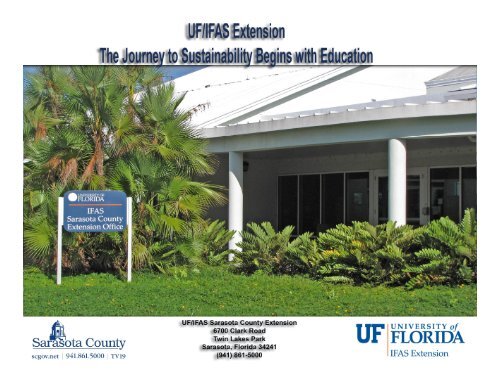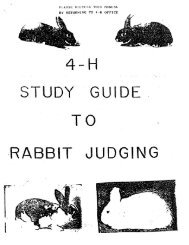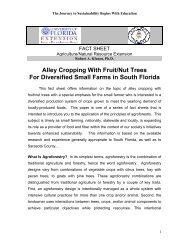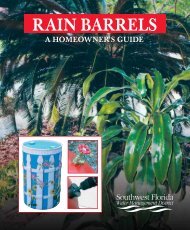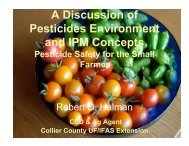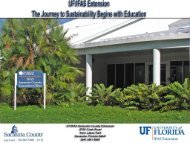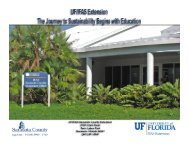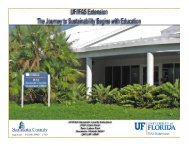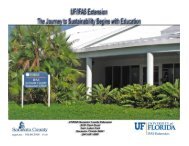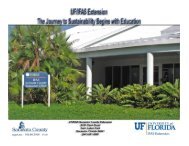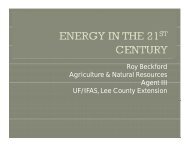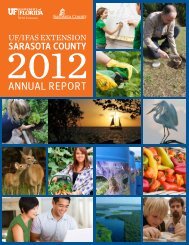Create successful ePaper yourself
Turn your PDF publications into a flip-book with our unique Google optimized e-Paper software.
Community GardeningOrganic Vegetable Gardening*<strong>Soil</strong> Management*Robert KlusonAg/NR <strong>Extension</strong> AgentUF/IFAS <strong>Sarasota</strong> <strong>County</strong> <strong>Extension</strong>
Syllabus of Presentation Series• Introduction to Organic VegetableGardening• <strong>Soil</strong> Management• Crop Management• Pest Management• Water Management• Cover Crops• Advanced Composting
Introduction• Goals of Presentation Series– Food for your freshest nutrition– Food for expanded community benefits– Food for thought– Food for your soul
Introduction• Approach of this presentation– Provide the concepts, and science fromagroecology of soil management practicesused in organic vegetable gardening– Provide resources in the managementpractices of soils and plant nutrition, inaddition to our text “Vegetable Gardening inFlorida” by James Stephens, UF/IFAS
<strong>Soil</strong> Appreciation Through History• “<strong>Soil</strong> Is The Mother Of All Things” . . .Chinese proverb• “Mother Earth” . . . similar expressions inmany cultures• Bierman, OSU; http://www.ag.ohio-state.edu/~prec/soil/slides/• “Feed the soil, not the plants” . . . organicfarming adagehttp://newfarm.rodaleinstitute.org/columns/research_paul/2005/1105/feedsoil.shtml
Food For The Soul"If fresh food is necessary tohealth in man and beast, thenthat food must be providednot only from our own soil butas near as possible to thesources of consumption."-Lady Eve Balfour
<strong>Soil</strong> Ecosystem & Plant Growth
Organic Vegetable Garden EcologyGarden Agroecosystem Examplecropspestssoil• <strong>Soil</strong> ecosystems have functional properties &subsystems (e.g., nutrient cycling,etc) from biodiversity
Agroecosystem Concept• An approach that looks at your vegetablegarden as a functional whole of interactingliving and non living components•• Analogy to the human body and its interactinglevels of molecules, cells, tissues, organs, andsystems.• Properties include:– Structural & functional levels– Hierarchical and temporal scales– Emergent properties - i.e., “whole is more than•sum of parts”Gliessman, S., 1999. Agroecology: Ecological Processes in Sustainable Agriculture
<strong>Soil</strong> Ecosystem ‘Emergent’Property Examples• Aggregation• <strong>Soil</strong> profile development• Nutrient cycling• Biotic mutualisms• Organic matter• <strong>Soil</strong> ‘quality’ and ‘health’Gliessman, S., 1999. Agroecology: Ecological Processes in Sustainable Agriculture
Aggregation Example• <strong>Soil</strong> structure– how components are held together not justcomposition– Indicator of good “tilth”– improved by root growth and organic matter– reduced by compaction and increased densityGershuny &Smillie, 1995,Soul of <strong>Soil</strong>.
Water Stable Aggregates• Formed by the aggregation of non-living(e.g., clay) and living (e.g., gluing togetherof macro-aggregates with bacterialsecretions, fungal hyphae, and root hairbonding) components.
<strong>Soil</strong> Profile Example• Arrangements oflayers or “horizons” ofsoils with particularcharacteristics.• Product of living andnon-living factors• Indicator of soil types,landscapes & ecosystemsExample: “Myakka fine sand”
<strong>Soil</strong> Survey Resource• <strong>Soil</strong>s information for land use planning• Highlights soil capabilities/limitationsfor many different users• Intended for a general level application• Available at county level• Accessible onlineGo to http://websoilsurvey.nrcs.usda.gov/app/
<strong>Soil</strong> Nutrient Cycle Example
Biotic Mutualism Example: Mycorhizae Myco (fungi) + rhizae (root) Serves as an expanded root system thatprovides water and nutrient benefits to plant hostPfleger and Linderman, 1994, Mycorrhizae and Plant Health.
Biotic Mutualism Example:Nitrogen-Fixing Bacteria• Nodulesformed whereRhizobiumbacteriainfected rootsof legumecrops• Convertsatmosphericnitrogen forplant uptake
Organic Matter• Influences almost all importantproperties that contribute to soilquality!• Range of values– Temperate soils have higher OM levels(5-10%)– Tropical soils generally have 0.5-1.0%(e.g., FL upland soils in native condition)
<strong>Soil</strong> Organic Matter• Composition– all living organisms(microorganisms,earthworms, etc),– fresh residues (oldplant roots, cropresidues, recentlyadded manures),– well-decomposedresidues (humus).<strong>Soil</strong> Resource Webpage, Univ. of MNhttp://www.soils.umn.edu/academics/classes/soil2125/
<strong>Soil</strong> Organic Matter Ecology• OM additions startrapid multiplicationof bacteria, fungi,and actinomycetes• As most readilyavailable energysources are used up,microorganismsagain becomerelatively inactive,• Leaving behind adark mixture usuallyreferred to ashumus – a stableorganic compound<strong>Soil</strong> Resource Webpage,Univ. of MN, http://www.soils.umn.edu/academics/classes/soil2125/
Humusa mixture of compounds and complex lifechemicals of plant, animal, or microbial originthat are resistant to decomposition and include:Fulvic AcidsHumic Acids
Function of Humus• increases water holding capacity• sticks together & helpsestablish and maintain a strongcrumb structure & aidsinfiltration• provides some nutrients (N & P)as it is slowly decayed bymicrobial activity at the rate of2.5% per year• buffers pH changes• creates good soil “ Tilth”• holds nutrients by increasingcation & anion exchangecapacity, and chelating capacityHumus =HighMediumLow
Composting• Art & science of producing stableorganic matter soil amendment by:– mixing organic materials properly– monitoring resultant biological activity• Types– aerobic– anaerobic digestion– worm (vermicomposting)
Composting Literature• Walt Whitman, “Behold This Compost” (1855)– A celebratory poem in his seminalbook ‘Leaves of Grass’“Something startles me where I thought I was safest,I withdraw from the still woods I loved . . .How can you be alive you growths of spring?How can you furnish health you blood of herbs, roots, orchards, grain?Are they not continually putting distemper'd corpses within you?Is not every continent work'd over and over with sour dead?Where have you disposed of their carcasses? . . .Behold this compost! behold it well!Perhaps every mite has once form'd part of a sick person--yet behold!The grass of spring covers the prairies,The bean bursts noiselessly through the mould in the garden,The delicate spear of the onion pierces upward, . . .What chemistry! . . .”http://classiclit.about.com/library/bl-etexts/wwhitman/bl-ww-thiscompost.htm
Composting Literature• Sir Albert Howard, “An AgricultureTestament” (1943)– Introduced Indore Compost MakingProcess– Foundation of organic gardening/farming• J.I Rodale, “Complete Book ofComposting” (1960)– Father of US organic gardening/farming
Aerobic Composting• Organic materials– carbon:nitrogen ratio = 30:1– less than 2-3 inches particle size– moisture (40-60 %)• Pile building and management– layers– aeration– volume (3’x3’x3-6’)• Monitoring– temperature rise (minimum 131 o F for 3 days)• Management– mixing/turning– finishing/curing– screening– maturity testsGo to http://compostinfo.com/
Aerobic Composting
Aerobic Composting
Aerobic Composting
Aerobic Composting
<strong>Soil</strong> Quality Definition<strong>Soil</strong> FertilityPhysical PropertiesBiological Activity“The ability of soil to function; to supplyplants with adequate nutrients, have gooddrainage and aeration, promote root growthand biological activity.”
<strong>Soil</strong> Health Definition• Definitions– Interactions between soil qualityand plant/animal/human quality– Sustaining and improving soilquality over the long term
What Is <strong>Soil</strong>?<strong>Soil</strong> will be studied as an ecosystemKourik, 1986, Designing & maintaining edible landscape naturally.
What is <strong>Soil</strong>?• 2 MAJOR PERSPECTIVES• Pedological (holistic) - a product of naturebased on– climate– living organisms– nature of parent material– topography of area– time• Edaphological (reductionistic) – a habitat forplants (e.g., for food/fiber production &landscapes)Brady, N.C. & R.R. Weil, 2003, Nature and Properties of <strong>Soil</strong>s
What is <strong>Soil</strong>?• A Mixture of Components• Pore Space 50% (v) Solids 50% (v)– water - minerals– air - organic matterBrady,1974,Nature andPropertiesof <strong>Soil</strong>s
<strong>Soil</strong> Mineral Components• Sand: largeparticles,0.05-2.0 mm indiameter.• Silt: mediumparticles, 0.002-0.05 mm. Settleswithin 48 hours.• Clay: extremelysmall particles,less than 0.002mm.
• Mineralcompostiondetermines<strong>Soil</strong> TextureClass• Florida gardensoils aretypically indifferent sandtextureclasses<strong>Soil</strong> Triangle
Textures Affect CapacitiesSand -Clay -Low LowHigh High
<strong>Soil</strong> pH• The measure of acidity or alkalinity ofthe soil• Determines the concentration ofnutrients in solution in the soil water(availability of nutrients for the plant)
<strong>Soil</strong> pH and Nutrients Availability
Adjusting <strong>Soil</strong> pH• To raise soil pH (make more alkaline): applylime (calcium carbonate) or dolomite(magnesium carbonate) - carbonatecompounds• To lower soil pH (acidify) temporarily: applyelemental sulfur compounds.• To add calcium or magnesium withoutchanging soil pH: use sulfate compounds(ex.: gypsum = calcium sulfate)
Plant Nutrition Concepts
• Principle of Limiting Factors–Justus von Liebig (1803-1873)• The research of the “father of the agricultural fertilizer industry”also acknowledged the importance of soil organic matter
Plant Nutrition Deficiencies
UF/IFAS Plant NutritionalDeficiencies WebsiteNitrogenMagnesium• User-friendly “decision tree” database• Ornamental plant examples primarily• Online at http://hort.ifas.ufl.edu/nutdef/
Plant Nutrition DeficiencyIdentification Caveats• Changes can be normal part of aplant’s cycle, e.g., iris foliage diebackor fall leaf colors• Often related to other problems– Pesticides– Disease– Insects– <strong>Soil</strong> factors– Environment (rainfall, wind, cold, etc)• In order to treat the problem, firstnecessary to diagnosis it correctly
<strong>Soil</strong> Chemistry & Plant NutritionPotassium(K)Example
Rhizosphere and Plant NutritionOMRoot TipRoot tip & OM contactRhizosphere OM decomposition Rhizosphere & protozoa Protozoa N wastes Clarhom, M.C., 1985Root uptakeof N wastes
<strong>Soil</strong> Life And Plant RootsCurl, E.A. & B.T. Truelove, 1986, The Rhizosphere.
<strong>Soil</strong> Life in <strong>Soil</strong> ProfileKourik, 1986, Designing & maintaining edible landscape naturally.• Protect topsoil as habitat for optimum soil life
<strong>Soil</strong> As Habitat for Biodiversity
EARTHWORMS• Earthworms dramatically alter soil propertiesfor growing conditions favorable for crop plants
Earthworm Benefits• Stimulate microbial activity• Mix and aggregate soil• Increase infiltration• Improve water-holding capacity• Provide channels for root growth• Bury and shred plant residue
<strong>Soil</strong> Testing• Program that includes:– nutrient analyses and interpretation– fertilizer & amendment recommendations– other considerations• salinity• elemental toxicity• <strong>Soil</strong> Testing Labs– UF/IFAS <strong>Soil</strong> Lab(http://soilslab.ifas.ufl.edu/)– Alternative <strong>Soil</strong>s Labs(http://attra.ncat.org/attra-pub/soil-lab.html
<strong>Soil</strong> Sampling• Representative sample = goal• Sample separately distinct areas
<strong>Soil</strong> Sampling
Soluble Salts Testing• <strong>Soil</strong> soluble salt levels are generallyclassified as damaging in the followingways:– 2100 ppm = very damaging levels, tolerableonly by the most salt-tolerant plants• As reference:– Fresh water (
Alternative <strong>Soil</strong> Test Example• <strong>Soil</strong>s, crops and livestock require balanced nutrition for health, justas people need a balanced diet to stay healthy. Organic farmersstrive to provide a 'balanced diet" for their farms by adding a varietyof organic materials and natural mineral amendments to the soil.M. Schonebeck, <strong>Soil</strong> Cation Nutrient Balancing in Sustainable Agriculturehttp://www.vabf.org/infosht.php
Alternative <strong>Soil</strong> Test Example“The Solvita® soil-life test kit provides animportant new tool for gardeners, farmers andscientists to evaluate soil microbial respiration ratein an efficient and cost-effective manner. <strong>Soil</strong>respiration is an important aspect of soil qualityand a good indicator of soil fertility.”“The Solvita test enables you to:•estimate annual nitrogen release based on soilbiological activity•evaluate organic matter sufficiency of soils•make overall judgements to fit into "soil quality"interpretation•achieve accuracy comparable to and less expensivethan Dräger tubes”
<strong>Soil</strong> Respiration Rate –the reality• More CO2 (carbon dioxide) coming off thesoil means the soil is respiring (breathing)more. This indicates either a high rate ofrespiration of existing organisms, or highnumbers, or both.• Having more organisms is a good thing, but ahigh respiration rate also means your soilsystem is burning off carbon…which lowersyour organic matter levels, which is a badthing.• High respiration rate is a result of optimaltemperatures, moisture, and aeration,sometimes as a result of tillage.
Alternative <strong>Soil</strong> Test ExampleHumus Testing[using LaMottehumus index test.]Newer garden soil withmulch = 1.0Improved garden soil =3.0Fresh worm compost = 5Near-by ag field (withsubsoil) = 0
Alternative <strong>Soil</strong> Test Example
Alternative<strong>Soil</strong> TestExample
Summary• Organic vegetable gardeningfundamentally depends ondeveloping a functional soilecosystem• Practices are designed toenhance soil quality and health• “Feed the soil so that the soil canfeed the plant”
• Cornell <strong>Soil</strong> HealthAcknowledgementshttp://www.hort.cornell.edu/soilhealth/• Janke, R., Sustainable Cropping Systems, KSU– <strong>Soil</strong> qualitywww.oznet.ksu.edu/rff/<strong>Soil</strong>%20Quality%20NEW.ppt– <strong>Soil</strong> tests interpretationswww.oznet.ksu.edu/rff/<strong>Soil</strong>%20Test%20Interpretation.ppt• Stromberger, M. Composting Organisms, CSUhttp://www.extsoilcrop.colostate.edu/<strong>Soil</strong>s/powerpoint/compost/CompostingOrganisms.pdf• USDA NRCS <strong>Soil</strong> Quality Institutehttp://soils.usda.gov/sqi/index.html


